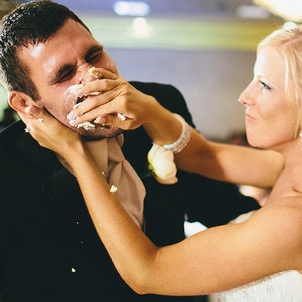12 Wedding "Rules" to Kick to the Kerb for a Modern Marriage
Categories: | Wedding Ceremony | Wedding Traditions |
 The
minute you announce you are engaged everyone,
friends, loved ones, wedding professionals, and even
slight acquaintances will start bombarding you with
"information" about what I call the dirty dozen
wedding "rules". Some of these so-called rules
make no sense at all in 2020, some are so laced with
outdated superstition that you'll wonder if you've
wandered into some sort of cult, and some are so
bizarre that you can't believe your ears. Gender
inequality/dominance and gender role stereotypes are
well and truly embedded in all of them. And one way
or another they all have something to do with sex
(disguised as fertility) or with sympathetic magic,
or with both of those things. So feel entirely
confident you can kick them to the kerb!
The
minute you announce you are engaged everyone,
friends, loved ones, wedding professionals, and even
slight acquaintances will start bombarding you with
"information" about what I call the dirty dozen
wedding "rules". Some of these so-called rules
make no sense at all in 2020, some are so laced with
outdated superstition that you'll wonder if you've
wandered into some sort of cult, and some are so
bizarre that you can't believe your ears. Gender
inequality/dominance and gender role stereotypes are
well and truly embedded in all of them. And one way
or another they all have something to do with sex
(disguised as fertility) or with sympathetic magic,
or with both of those things. So feel entirely
confident you can kick them to the kerb!Let's break it down.
A wedding ceremony is, simultaneously, a public commitment of love, a formal intention that changes your legal status, and a celebration shared with friends and loved ones. As such, it is a personal occasion, but a personal occasion that lays a critical foundation for your future.
There are no "rules" (other than minimal legal requirements). What there is, is tradition. In other words, someone did something some time ago which others thought was a good idea so they repeated it and others also repeated it until it became so woven into the fabric of weddings that is has become tyranny. These traditions have been handed down from mediaeval social and relationship conventions, solidified by the church, from generations of society weddings that imitate Queen Victoria's wedding,and from more recently invented rituals.
Same sex couples have already ditched many of these tyrannical traditions. Yay for them! And the sky did not fall in. In fact, weddings improved out of sight, becoming more fun, and more authentic to the couple. Dare to be yourselves. Dare to say "We don't" so that you have a wedding that you feel comfortable with, a wedding that is all about who you are, that is more than just retelling your story embedded in a lot of outdated traditions. A wedding that is a wonderful window into your way of being when you are together. A wedding that everyone present will remember in a good way.
Here are my top picks for "rules" to kick to the curb.
Not seeing one another
before the wedding
Something old, new,
borrowed, blue
Expensive white dress
The huge skirt princess dress has the same provenance. When Queen Victoria married every woman wore dresses with huge skirts, numerous petticoats, a tightly laced corset, and the biggest, longest knickers you can imagine (with a split in the crotch to allow the wearer to go to the loo without undressing).
Veil
Matchy matchy bridal
parties
The big handover
Separate and surprise vows
Rings
Hence all the stories of eloping couples getting married using a brass curtain ring, and people still believing, to this day, that With this ring, I thee wed is a legal requirement so they must have rings. Many celebrants still carry cheap substitute rings in case anyone forgets the rings. Exchange rings if you want to. Exchange something else if you'd rather - I've had couples exchange other types of jewellery and even blinged-up flash drives. Or just skip that part. And if you decide that you will exchange rings but forget to bring them, you can be totally relaxed about it. Hint: Read my blog post OMG We forgot the rings
Permission to kiss
Throwing things
It is rather curious that there are so many
wedding traditions that involve throwing things.
We've long ago dropped the custom of throwing
shoes at the couple (derived from the older
association of shoes with transfer of property),
but have hung on to the custom of throwing
symbolic somethings at the couple to ensure
fertility and prosperity. Wheat, thrown in Ancient
Greece, has evolved into rice, confetti, and
petals. And there are those other two bizarre
throwing episodes. The bride throwing her bouquet
to all the unmarried women in order to transfer
her luck at getting married to the next potential
bride, the woman catching it being deemed to be
the next to get married, and the groom burrowing
under the bride's dress to grab her garter and
toss it to the guys, in the hope that the lucky
bloke who catches it will be the next to get laid.
Yes, that's the real tradition, not the cleaned up
version we have nowadays.
All that messy nonsense
with the cake
Cakes have become lighter, and icing much easier to slice through, and we've imported the American custom of feeding one another a bit of cake, purported to symbolise the couple's commitment to provide for one another. But that symbolism has been lost in the newish "tradition" of smearing or smashing cake into one another's face. Not a good look. No one is quite sure where that started but we do have a reference in Curious Customs, a book by Tad Tuleja, published in 1987 that describes the cake smash as "four-step comedic ritual that sustains masculine prerogatives in the very act of supposedly subverting them." Tujela is an anthropologist, so his detailed description is well-researched, worth quoting, and quite confronting:
Until early in this century [the 20th] the bride cut the bride herself because of the belief ... that "if anyone else cuts into the cake first, the bride's happiness and prosperity are cut into". Now, in the first step of the comedy, the groom helps direct the bride's hand - a symbolic demonstration of male control that was unnecessary in the days of more tractable women. She accepts this gesture and, as a further proof of submissiveness, performs the second step of the ritual, offering him the first bite of cake, the gustatory equivalent of her body, which he will have the right to partake of later. In the third step, the master-servant relationship is temporarily upset as the bride mischievously pushes the cake into her new husband's face ... Significantly, this act of revolt is performed in a childish fashion, and the groom is able to endure it without losing face because it ironically demonstrates his superiority. His bride is an imp needing supervision. That the bride herself accepts this view of things is demonstrated in the ritual's final step, in which she wipes the goo apologetically from his face. This brings the play back to the beginning, as she is once again obedient to his wiser judgment.
First Dance
Thanks for reading!
